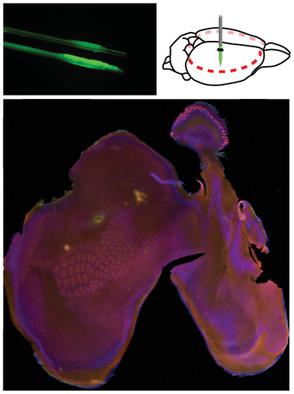当前位置:
X-MOL 学术
›
Adv. Mater. Technol.
›
论文详情
Our official English website, www.x-mol.net, welcomes your feedback! (Note: you will need to create a separate account there.)
Chitosan‐Based, Biocompatible, Solution Processable Films for In Vivo Localization of Neural Interface Devices
Advanced Materials Technologies ( IF 6.8 ) Pub Date : 2019-12-18 , DOI: 10.1002/admt.201900663 Onni J. Rauhala 1, 2 , Soledad Dominguez 1 , George D. Spyropoulos 2 , Jose Javier Ferrero 1 , Talia R. Boyers 1 , Patricia Jastrzebska‐Perfect 2 , Claudia Cea 2 , Dion Khodagholy 2 , Jennifer N. Gelinas 1, 3
Advanced Materials Technologies ( IF 6.8 ) Pub Date : 2019-12-18 , DOI: 10.1002/admt.201900663 Onni J. Rauhala 1, 2 , Soledad Dominguez 1 , George D. Spyropoulos 2 , Jose Javier Ferrero 1 , Talia R. Boyers 1 , Patricia Jastrzebska‐Perfect 2 , Claudia Cea 2 , Dion Khodagholy 2 , Jennifer N. Gelinas 1, 3
Affiliation

|
Chitosan (CS) is a biocompatible, inexpensive organic polymer that is increasingly used in neural tissue applications. However, its intrinsic fluorescence has not yet been leveraged to facilitate localization of neural interface devices, a key procedure to ensure accurate analysis of neurophysiological signals. A process is developed to enable control of mechanical and chemical properties of CS‐based composites, generating freestanding films that are stable in aqueous environments and exhibit concentration‐dependent fluorescence intensity. The shape and location of CS‐coated probes are reliably visualized in vitro and in vivo using fluorescence microscopy. Furthermore, CS neural probe marking is fully compatible with classical immunohistochemical and histological techniques, enabling localization of high spatiotemporal resolution surface electrocorticography arrays in adult rats and mouse pups. CS composites have the potential to simplify and streamline experimental procedures required to efficiently acquire, localize, and interpret neurophysiological data.
中文翻译:

基于壳聚糖的,生物相容性,溶液可处理的膜,用于神经接口设备的体内定位
壳聚糖(CS)是一种生物相容的廉价有机聚合物,越来越多地用于神经组织应用。但是,尚未利用其固有的荧光来促进神经接口设备的定位,这是确保对神经生理信号进行准确分析的关键程序。开发了一种工艺来控制CS基复合材料的机械和化学性能,生成在水环境中稳定并表现出浓度依赖性荧光强度的独立膜。使用荧光显微镜可以在体外和体内可靠地观察CS涂层探针的形状和位置。此外,CS神经探针标记与经典的免疫组织化学和组织学技术完全兼容,可以在成年大鼠和小鼠幼仔中定位高时空分辨率的表面皮质脑电图阵列。CS复合材料具有简化和简化有效获取,定位和解释神经生理学数据所需的实验程序的潜力。
更新日期:2020-03-09
中文翻译:

基于壳聚糖的,生物相容性,溶液可处理的膜,用于神经接口设备的体内定位
壳聚糖(CS)是一种生物相容的廉价有机聚合物,越来越多地用于神经组织应用。但是,尚未利用其固有的荧光来促进神经接口设备的定位,这是确保对神经生理信号进行准确分析的关键程序。开发了一种工艺来控制CS基复合材料的机械和化学性能,生成在水环境中稳定并表现出浓度依赖性荧光强度的独立膜。使用荧光显微镜可以在体外和体内可靠地观察CS涂层探针的形状和位置。此外,CS神经探针标记与经典的免疫组织化学和组织学技术完全兼容,可以在成年大鼠和小鼠幼仔中定位高时空分辨率的表面皮质脑电图阵列。CS复合材料具有简化和简化有效获取,定位和解释神经生理学数据所需的实验程序的潜力。


























 京公网安备 11010802027423号
京公网安备 11010802027423号